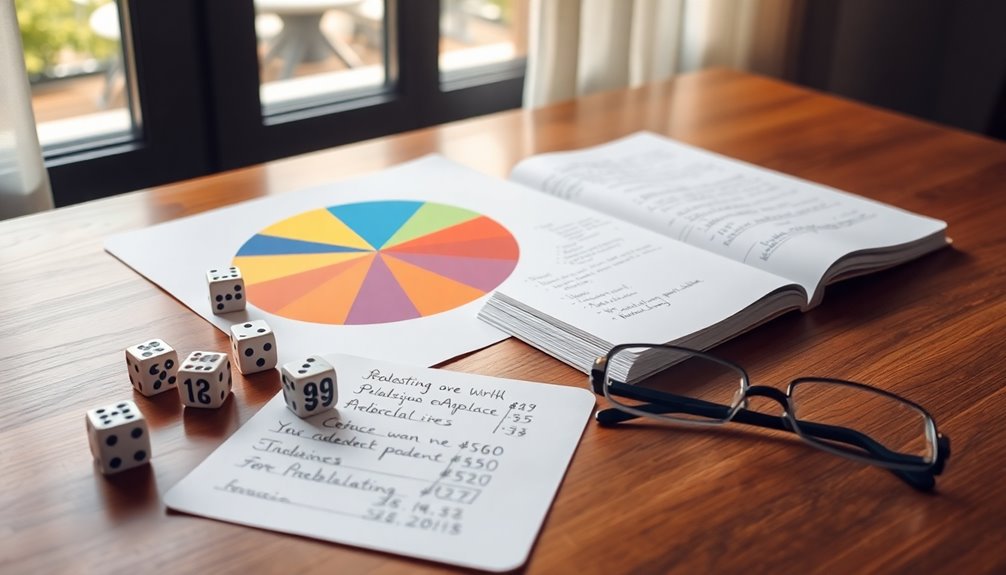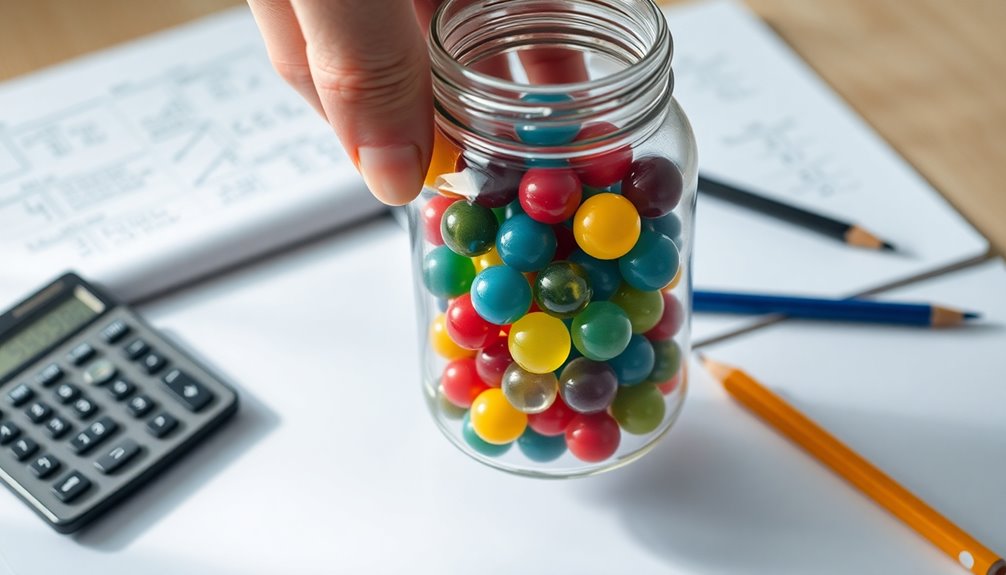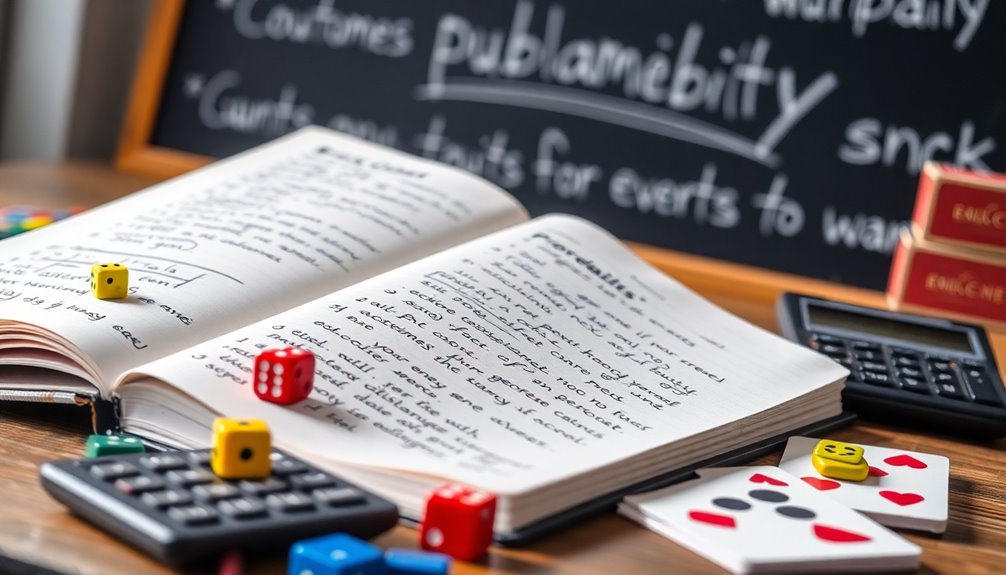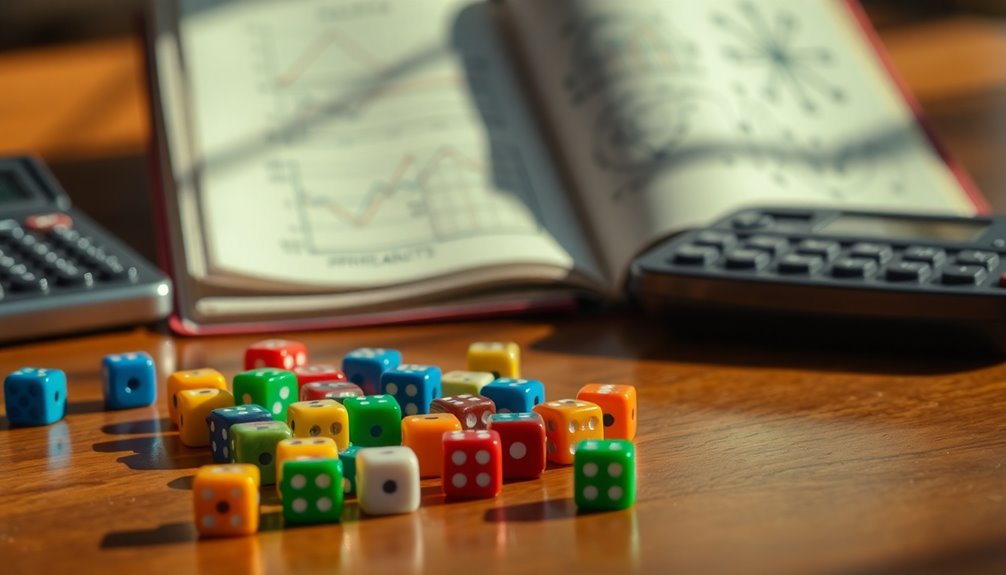Understanding probability doesn't have to be daunting. You'll start by learning the basics, which involve quantifying uncertainty and using simple formulas like P(E) = Favorable outcomes / Total outcomes. You'll discover different types of probability, such as theoretical and experimental, and how to calculate them step by step. This guide will also cover essential concepts like the addition and multiplication rules, making decision-making more informed. Real-world applications, from weather forecasting to insurance, highlight probability's significance in everyday life. Keep exploring, and you'll uncover even more about mastering this valuable skill.
Key Takeaways
- Probability quantifies uncertainty, calculated as the ratio of favorable outcomes to total outcomes, ranging from 0 to 1.
- Understanding different types of probability—such as theoretical, experimental, and conditional—enhances clarity in various contexts.
- Key rules like the Addition Rule and Multiplication Rule help simplify complex probability calculations for events.
- Real-world applications include weather forecasting, sales predictions, and risk assessment in insurance, illustrating the importance of probability in decision-making.
- Mastering foundational concepts like sample space, random variables, and distributions is crucial for accurate probability analysis.
Understanding Probability Basics

Probability is a fundamental concept that helps you quantify uncertainty in various situations. Essentially, it's the ratio of favorable outcomes to the total outcomes of an event.
To calculate probability, use the formula P(E) = Number of favorable outcomes / Total number of outcomes. Values range from 0, meaning an event is impossible, to 1, indicating certainty. Theoretical probability is often calculated based on equally likely outcomes, which simplifies the process for basic events.
You can determine the sample space by listing all possible outcomes and counting them. For example, if you're rolling a die, there are six outcomes. If you want to find the probability of rolling a number less than 5, count the favorable outcomes and divide by the total.
This foundational understanding of probability sets the stage for further exploration into its applications and rules.
Types of Probability

Understanding the basics of probability lays the groundwork for exploring its various types.
You'll encounter theoretical probability, which uses the formula P(Y) = Z/X, where Z is the number of favorable outcomes. It assumes all outcomes are equally likely. In theoretical probability, the total probability of all events in a sample space equals 1.
Then, there's experimental probability, based on actual trials; you calculate it by dividing the number of times an event occurs by the total trials.
Axiomatic probability follows Kolmogorov's three axioms to provide a consistent framework.
Lastly, subjective probability stems from personal beliefs or judgments, often used when data is scarce.
Each type serves a unique purpose, helping you understand and assess probability in different situations.
Calculating Probability

Calculating probability involves a straightforward process that can be broken down into clear steps. First, define the specific event you're interested in. Next, determine the number of favorable outcomes for that event. Then, find the total number of possible outcomes. You can calculate the probability by dividing the number of favorable outcomes by the total outcomes. For example, when rolling a die, the probability of getting a "3" is 1 favorable outcome out of 6 total outcomes, which equals 1/6. Understanding the different types of probability can also enhance your calculations.
If you're dealing with multiple independent events, calculate the probability of each event and multiply them together. For instance, rolling two dice and getting "6" on both results in a probability of 1/36.
Real-World Applications

Many areas of life rely on probability to make informed decisions and predictions. For instance, meteorologists use it to forecast weather, like predicting an 80% chance of rain, helping you plan your day. Probability also plays a crucial role in assessing the risk of natural disasters, which informs community preparedness and resource allocation.
In economics, retailers forecast sales to manage inventory effectively, while insurance companies assess risks to determine premiums. Health insurance providers utilize probability to estimate healthcare costs based on factors like age and medical history.
In technology, you encounter probability daily—whether it's predicting traffic patterns, receiving tailored recommendations on Netflix, or enhancing cybersecurity measures.
Key Concepts and Rules

Probability is a fundamental concept that helps you make sense of uncertainty in various situations. To navigate this, you need to grasp some key rules.
The Addition Rule helps you find the chance of either event A or B occurring. If events are mutually exclusive, simply add their probabilities.
The Multiplication Rule is for finding the probability of both A and B happening, especially useful for independent events. Understanding that independent events do not influence each other's probabilities is crucial for applying the Multiplication Rule effectively.
The Complement Rule allows you to calculate the probability of an event not occurring.
Lastly, the Law of Total Probability breaks down complex events into simpler parts.
Understanding these rules will empower you to analyze situations and make informed decisions based on probability!
Visual Representations and Tools

Visual representations and tools play a crucial role in understanding probability concepts and making complex data more accessible. Probability plots help you assess how well your data fits a specific distribution, highlighting any deviations from a normal pattern. Tree diagrams are essential for visualizing all potential outcomes, especially with independent events, allowing you to work through probability problems step-by-step. Software tools like Microsoft Visio or the vistributions package can simplify creating these visuals, enabling customization and accurate calculations. Additionally, the vistributions package provides a user-friendly interface for statistical distribution analysis, making it easier to visualize and understand different probability distributions. Bullet points enhance readability in academic writing, breaking down intricate information into manageable segments, which is particularly useful for summarizing methods or results.
Advanced Probability Topics

As you dive into advanced probability topics, you'll encounter a range of concepts that deepen your understanding and application of probability theory.
You'll explore probability distribution functions, including density and mass functions, along with cumulative distribution functions. Moment-generating functions will help you derive moments and identify distributions.
The Central Limit Theorem reveals how sample means converge to a normal distribution as sample size increases. You'll also learn about heavy-tailed distributions, which feature extreme values more frequently than normal distributions.
Stochastic processes like Markov chains and Poisson processes illustrate how events unfold over time. Plus, conditional probability and Bayes' theorem will enhance your ability to update probabilities based on new evidence, making your grasp of probability more robust. Bayesian networks are particularly useful in modeling complex relationships among variables and aiding in decision-making processes.
Practical Examples and Exercises

Understanding advanced probability concepts is important, but applying them through practical examples and exercises solidifies your knowledge. Start with basic probability questions, like identifying impossible events—such as selecting an odd number from 1 to 10—and certain events, such as picking any number in that range.
Next, define sample spaces, like the letters in "LIBRARY," to understand all possible outcomes, as sample space includes every potential result in an experiment.
Move on to card selection probabilities by calculating the chance of drawing a non-ace from a deck or a specific card. Practice with marbles, noting the differences between drawing with and without replacement.
Finally, delve into conditional and combined probabilities to solve real-world problems, like determining the likelihood of shared birthdays in a group.
Tips for Mastering Probability

To master probability, you need a solid grasp of its fundamental concepts and practical applications. Start by understanding probability spaces, events, random variables, and distributions. Familiarize yourself with key properties like mean and variance, and get comfortable with conditional probability and independence. Additionally, understanding statistical independence helps you recognize when the occurrence of one event does not affect another.
Mastering Bayes' theorem is crucial for updating probabilities based on new information.
Use visual aids like graphs, tree diagrams, and Venn diagrams to clarify complex ideas. When tackling problems, declutter the question to identify key elements, and break tasks into manageable parts.
Lastly, apply probability to real-world scenarios, like medical testing and financial forecasting, to see its relevance. By following these tips, you'll build a strong foundation in probability.
Frequently Asked Questions
How Can I Apply Probability in Everyday Decision-Making?
You can apply probability in everyday decision-making by assessing risks and outcomes.
For example, when deciding whether to carry an umbrella, consider the forecast's rain percentage. In traffic, use probability to choose the best time to leave to avoid congestion.
When shopping, analyze sales trends to predict which items will be in stock.
What Are Common Misconceptions About Probability?
You might think that random sequences need to self-correct, leading you to expect patterns where none exist.
It's easy to believe that small samples accurately reflect larger populations, but they often don't.
You could also fall for the gambler's fallacy, assuming future events will balance out past outcomes.
How Does Probability Relate to Statistics?
Probability and statistics are closely linked. When you use probability, you predict future outcomes based on a known model.
In contrast, statistics analyzes past data to infer characteristics about larger populations. Probability lays the groundwork for statistical inference, helping you draw conclusions from sample data.
Can Probability Predict Future Events Accurately?
Can probability predict future events accurately? While probability offers a framework for making educated guesses about outcomes, it isn't foolproof.
You're often dealing with uncertainties, and even slight changes in initial conditions can lead to vastly different results. Factors like measurement limits and unobserved events can also hinder accuracy.
What Role Does Randomness Play in Probability?
Randomness plays a crucial role in probability by introducing uncertainty and variation in outcomes.
You can think of it as the foundation for calculating probabilities, as it allows you to analyze how likely certain events are to occur.
When you observe random processes, like tossing a coin, you see that outcomes may vary, but over time, you'll notice stable frequencies.
This stability helps you make informed decisions based on the likelihood of future events.
Conclusion
In conclusion, you've taken a significant step towards understanding probability. By grasping the basics, exploring different types, and applying concepts to real-world situations, you're now better equipped to tackle challenges in this field. Remember to utilize visual tools and practice regularly to reinforce your skills. As you dive into advanced topics, keep your curiosity alive. With persistence and practice, mastering probability is within your reach. Embrace the journey, and enjoy the learning process!









